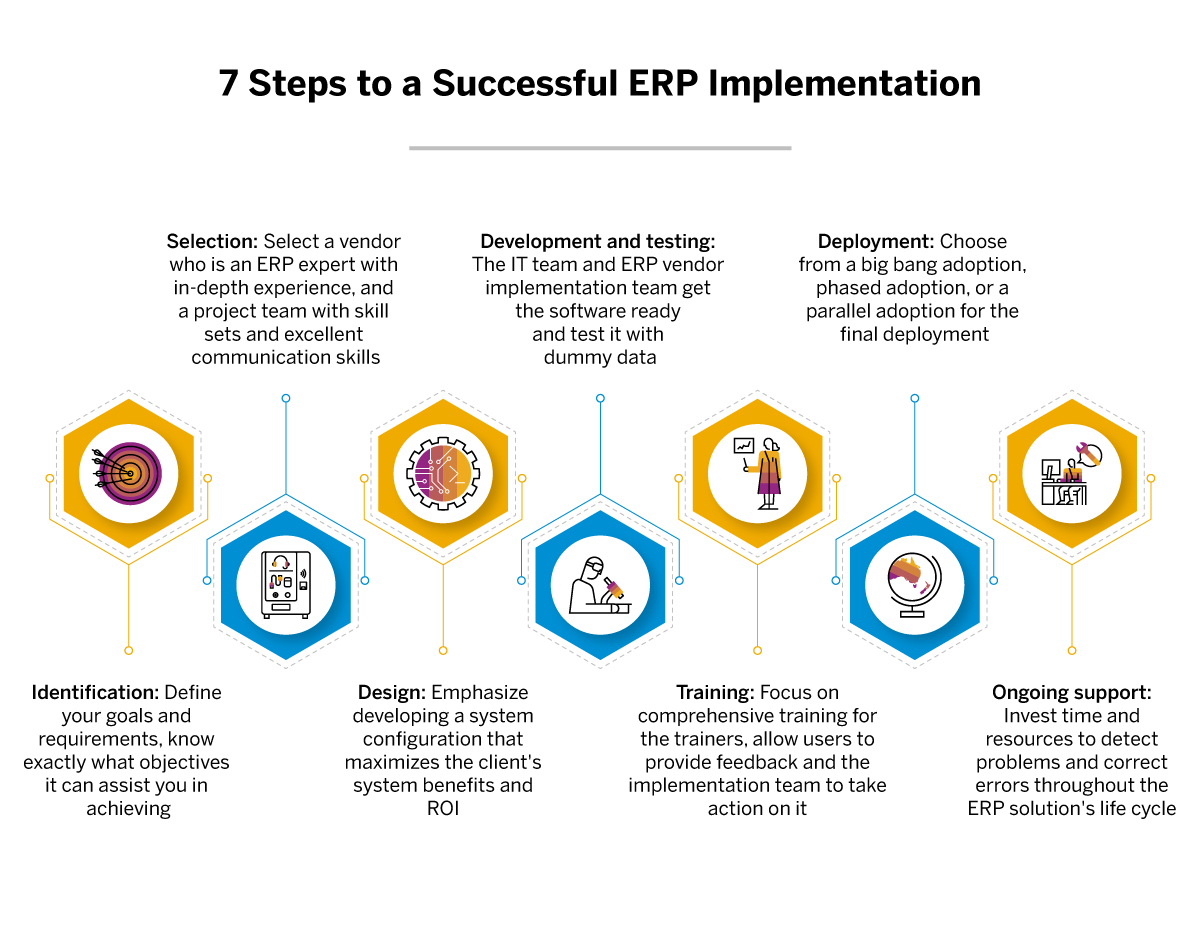Implementing an ERP (Enterprise Resource Planning) system for the first time can be challenging, since a lot of work and planning is required before the benefits become visible. The most significant challenge is that it not only alters the technology employed but it also has a substantial impact on your company’s culture.
However, when done correctly, deploying ERP software can be a rewarding decision. The global business community has realized this, and ERP adoption is increasing by leaps and bounds. According to a study, the ERP market revenue is expected to reach $66.38 billion by 2026, with a CAGR growth rate of 8.2%. While ERP software implementation is mainly seen in big businesses, the small business ERP segment is also showing growth.
An ERP system adds to your competitive advantage by synchronizing all of your information and streamlining workflows. In fact, a self-reported study found that 97% of the businesses that successfully implemented an ERP improved business operations. 86% of the companies that completed ERP implementation showed better reporting and visibility. An ERP software can improve coordination between departments and ensure lower time to market and delivery time. A cloud-based ERP system can also provide automation capabilities by using third-party software.
Clearly, ERP implementation has proven benefits such as-
- Enhanced business reporting
- Better customer service
- Improved inventory costs
- Better cash flow
- Cost savings
- Better data security
- Business process improvements
- Supply chain management
A good example of successful ERP implementation and the consequent organizational growth was seen in the case of Tata Steel (TISCO). TISCO implemented the SAP ERP system in 1999, and a detailed study was done to understand the benefits of this move. The study found that the coordination among different departments increased at the Tata Steel Ltd. Jamshedpur plant. Production-linked data was collected automatically, which resulted in faster and error-free processes. As a result of these business processes becoming more efficient, customer service and productivity too improved. Even the workforce cost reduced substantially, falling from US$200 per ton in 1998 to about US$140 per ton in 2000. The carrying cost of inventory was also decreased significantly. Consequently, most of the investment made for deploying the ERP system was recovered within a few months.
However, simply going live with the new solution is not the same as a successful ERP implementation. To ensure your business stays competitive and leverages the full potential of the software, here are the steps you should follow to ensure a successful implementation:

- Identification – Prior to deploying any ERP solution, it’s critical to define your goals and requirements. Given the numerous advantages of an ERP system, you may have a general notion of what it can do for your company, but do you know exactly what objectives it can assist you in achieving? For example, are you facing trouble with legacy systems? Or is low customer retention and low customer satisfaction undercutting your efforts? Depending on your end goals, you can define KPIs and measurable goals that you want to achieve with the help of the ERP.When TISCO decided to migrate to SAP, it was facing several issues with its legacy systems, causing dissatisfaction among customers since their problems were not being addressed and resolved. This led to lower sales and low customer retention. Also, the legacy systems were prone to errors, which affected customer satisfaction again, directly impacting sales and the top line and bottom line. These issues were highlighted by the management and were resolved by the new ERP.
- Selection– Selecting a vendor and putting together a project team is arguably the most crucial phase in ERP implementation. When it comes to choosing vendors, instead of opting for general software experts, you should look for ERP experts with in-depth experience implementing ERP solutions. Your preferred partner must have a thorough understanding of your organization, including the verticals in which you operate and your customers. Here is what needs to be kept in mind in this phase.
- While selecting the project team- Before you choose your project team, it is essential to understand that ERP implementation is not only an IT project but a business project which requires coordination between all departments. The process should be defined by employees with clear visibility into different aspects of the business. But the key factor here should be competency, not their position in the hierarchy. Your core team members require experience, skill sets, adaptability to change and excellent communication skills. Since ERP systems are implemented company-wide, including the CEO, CTO, and CIO is advisable. If some team members are continuously playing catch up, it can delay the whole process. Allow your finest employees to work on the project and accept that their capacity to conduct their regular tasks will be severely limited or non-existent for the time. They will need to focus on key tasks such as defining requirements, attending vendor demonstrations, shortlisting and selecting the vendors etc. Thus, the internal ERP team should be ready to dedicate at least 25% of their weekly work time to this.
- While selecting the ERP vendor- The first step in ERP vendor selection is determining the requirements. An ERP software is to be used by all the departments and therefore, these requirements should come in from all departments, the IT team and the top management. Next, critical success factors should be determined and these need to be used to evaluate and compare different vendors. Next, ERP vendors should be asked to submit their bids. The vendors should be evaluated on various parameters such as functional capability, system integration ability, processes coverage, technological capability, implementation and maintenance costs, and vendor support. A shortlist should be prepared and then a detailed discussion should be done with these shortlisted vendors.
- Design– In the design phase, the project team and the vendor will decide the processes, along with user roles and standard operating procedures. The emphasis is on developing a system configuration that maximizes the client’s system benefits and ROI. The implementation team will work with the customer to translate their system requirements into possible configuration options. Next, they will collaborate closely with the project team to define the configurations and implementation techniques that will lead to the project’s development phase. In short, this phase will see the development of a blueprint, which will act as a bridge between the business, the project team, and the ERP specialists to keep everyone on the same page. The blueprint will serve as the base for all future development, and it should include each minute detail, such as project tasks and processes, with a sign-off from respective process heads.
- Development and testing– Once the tasks are finalized, the IT team and the ERP vendor implementation team will get the software ready and also create training modules for future users. The testing phase overlaps with the development phase and includes testing with dummy data. The importance of using the correct data is often overlooked in the overall process but the experience of a major energy utility, San Francisco’s Pacific Gas and Electric, explains why this is critical. A manager picked a live information database to utilize during pre-launch testing. This resulted in sensitive company information being revealed, resulting in a slew of expensive recovery efforts as well as a loss of public trust in the company’s reputation. Clearly, it can be costly and time-consuming to make changes when your installation is nearly complete. Test software and processes as much as possible to ensure that the implementation is achieving what it should be. Measure results throughout the deployment period to assess how well the ERP is accomplishing your goals. Coming back to the example of TISCO, this phase threw up several errors and unexpected results. Even after extensive brainstorming and research in the beginning, the blueprint had to be changed from time to time and new requirements were added.
- Training– It takes a lot of time and effort to train users, especially when employees are expected to continue doing their regular jobs during the process. The length of time it takes will be determined not only by the size and complexity of the ERP solution, but also by the employees’ attitude toward changing their working habits. Focus on comprehensive training for the trainers. Allow users to provide feedback and the implementation team to take action on it. The chance of lost productivity after deployment will be reduced if users, trainers, the implementation team, and the vendor communicate consistently and meaningfully.
- Deployment– Once the software is ready, the next step is the final deployment, where it will work on live data and replace legacy systems. There are three ways to do this final deployment:
- Big bang adoption– The switch between ERP adoption and phase-out of legacy systems occurs on one date. It is an instant changeover where the entire organization moves to the new system instantly.
- Phased adoption– In phased adoption, some processes move to the new system first. The remaining operations move to the new system in a phased manner.
- Parallel adoption– In parallel adoption, the new and legacy systems are used simultaneously for some time. If the ERP works correctly, the legacy systems are phased out entirely and the new ERP becomes the default software.
On the go-live date, your organization should be adaptable and ready to face any unanticipated obstacles. Users should be able to check, document, and amend business processes in the live ERP system with the help of IT. Have extra IT staff on hand, as well as individuals that are willing to work overtime. Prepare a communication strategy in the event of a system outage.
- Ongoing Support– Once the system is in use, it will likely face challenges like new process addition, process changes, feature enhancement, etc. This necessitates continual software maintenance as well as user support. Investing time and resources to detect problems and correct errors will be critical throughout the ERP solution’s life cycle. The challenges can be easily mitigated if the ERP vendor provides ongoing support, which should help ensure continuity and future readiness. For small business ERP software, ongoing support is of utmost importance due to the lack of IT resources.
The blueprint and the training modules also need to be regularly updated with every successive change. This too requires ongoing support from the vendor.
You can notice substantial gains in your business if you use the appropriate methods and strategies for ERP implementation. But one of the critical factors in ensuring success is choosing a vendor who can combine industry knowledge, previous experience and an in-depth understanding of your unique needs and requirements. With varied and extensive expertise in ERM implementation across industries, SAP helps you achieve the critical competitive edge to move ahead in the race.



